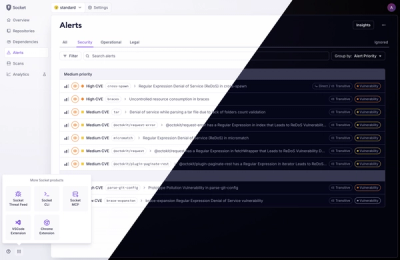
Product
A Fresh Look for the Socket Dashboard
We’ve redesigned the Socket dashboard with simpler navigation, less visual clutter, and a cleaner UI that highlights what really matters.
github.com/starsoftanalysis/lightboxssa
LightboxSSA is small Javascript program, with some CSS, that can be used to overlay images on top of the current page for viewing as a lightbox.
This repository is arranged so that it can be used as a Hugo module, but the components can be used on non-Hugo sites too.
This is yet another fork of Lokesh Dhakar's excellent Lightbox2.
{{<figset>}} and {{<figrow>}} shortcodes.The examples directory in this repository contains a simple website showing some of the features of lightboxSSA. If you download
the repository, you can view the example website using a local server by running, for example,
python -m http.server 8000
and pointing your browser at localhost:8000.
The CSS component of lightboxSSA is written in SASS, but the distribution includes the compiled CSS in the examples folder
if required.
Include the Javascript and SASS/CSS in the usual way, keeping the images directory in the same
place relative to the js and css directories, because the Javascript and CSS both use relative URLs to find the
dynamic cursor images.
LightboxSSA can be used with Hugo (version 0.120 or later), either as a module or a theme.
Needs Dart SASS -- use option transpiler: dartsass.
You ust need to include something like
'''
{{ partial "lightboxSSA.html" . }}
'''
in your partials/head.html or equivalent.
That will put the JS and CSS on pages
that have lightboxssa: active: true in their frontmatter.
To include lightboxSSA JS and CSS on every page,
put
lightboxSSA: active: true
(with other options if required, see below)
in the site's configuration file (config|hugo.yaml|toml)
within the params section.
If you want to adjust any options for the whole site, use something like this:
# config.yaml
...
params:
lightboxSSA:
active: true
overlay_opacity: 0.9
wrap_around: true
The appearance of the lightbox can be tuned with a number of parameters, set via a Javascript object. Include something
like this in the HTML, either in the <head> or at the end of the <body>.
const lightboxSSA = {
overlay_opacity: 0.9,
wrap_around: false,
};
The settable options are:
disable_scrolling: Hide the scrollbar so that lightbox uses full area of the window. true/false Default: truefade_duration: The time in ms to fade from one image to the next. Default: 600max_height: The maximum height of the image, as a percentage of the screen width. 10 - 100 Default: 95%max_width: The maximum width of the image, as a percentage of the screen width. 10 - 100 Default: 95%overlay_opacity: The opacity of the overlay that is displayed behind the lightbox image. Valid values are between 0.00 (clear) and 1.0 (completely opaque). Default: 1.0overlay_colour: The colour of the overlay, expressed in any CSS colour format, such as #aa22ff or rgb(30,100,2200)swipe_min: The minimum distance for a swipe gesture to be accepted, as a fraction of the screen size. 0.0 - 1.0 Default: 0.1wrap_around: Whether or not the gallery feature will wrap around at each end. true/false Default: trueactive: For Hugo sites only. Set this to true to include the lightboxSSA javascript and CSS on the page (or on all pages if
the setting is in the site's configuration file). true/false Default: falselightboxSSA can be used with the {{<figure>}}, but note that it uses title=... to create an h4 element within the <figcaption>, and follows it
with the contents of the caption= attribute, rather than using title as a tooltip for the image as you might expect.
The {{<figset>}} and {{<figrow>}} shortcodes were designed to work together with lightboxSSA, and do a better job.
Note that with Hugo's figure shortcode, data-lightbox doesn't get passed on to the HTML <figure> element; so use class="lightbox-...".
Or use the figset shortcode.
A lightbox can be attached to any element, but only makes sense for an <img> or for a <figure> that contains an <img>.
The link from the figure or image to the lightbox is achieved in one of two ways: with a data-lightbox attribute, or by
applying a lightbox-... class. For example:
<img data-lightbox=img1 src="thingy.png">
or
<img class="lightbox-img1" src="thingy.png">
The value of the data-lightbox=.../class=lightbox-... attribute (aka the gallery name) is used to group images into galleries. Use a unique attribute,
or no attribute, to create a lightbox for a single image with no gallery.
If you mix data-lightbox=.../class=lightbox-... attributes with the same gallery name, the order of the images in the gallery won't be
in DOM order, so do one or the other.
The lightbox will take details (caption, title, alt text, etc.) from the img or the figure, or both. If the lightbox is attached
to a <figure>, it will look for details in the enclosed <img> first, and then from the figure element. If the lightbox is attached
to an <img>, it will NOT look at any enclosing <figure>.
To make it more complicated, there are two ways of supplying some of these details: with data-... attributes, or with the usual
figcaption, title, and alt attributes. data-... attributes take precedence. The reason for this is to allow
the details on the lightbox to be different from those on the main page.
The details that can be set are:
src=... -- in the img's src attribute. The name (URL) of the image, e.g. /images/photo1.png, or https://example.com/remote.jpg.data-url=... -- an URL to link to when the user clicks on the image from within the lightbox.data-title=... or title=... -- The title, used as a tooltip when the mouse pointer is over the image.data-alt=... or alt=... -- The alt text for the image.data-caption=... or <figcaption>...</figcaption> -- The caption to display with the image. If the image is part
of a <figure>, the figcaption text will be used, unless overridden by data-title in the image or figure elements.srcset to use with the image.
Note that data-sizes is not needed: lightboxSSA will calculate calculate a suitable sizes value for use within the lightbox.Examples:
<figure data-lightbox="example-2" data-caption="A different caption for the light box" data-title="Lightbox-only title">
<img src="/photos/pic2.jpg" width=300 alt="Looking down at a calm sea from the top of a chalk cliff">
<figcaption>A cliff, can't remember where</figcaption>
</figure>
Use title= for tooltip on main page, will also be tooltip on lightbox; data-title= will only show up on lightbox (overriding title=). Likewise for caption and data-caption. And alt. This is complicated -- see addToAlbum() FIXME e.g. if there's a figure with an image, either may have the title or data-title Rule: data- attributes take precedence -- they can override those without data- because they are unique to the lightbox, e.g. '<img data-title=x title=y ... > uses y on the main page, x on the lightbox.
class=lightbox-... and data-lightbox=..., the order
of the images in the gallery may not match the order on the main screen.I don't use things like Bower or Grunt, so there are just SCSS and JS files for people to use as they wish.
This project is licensed under the terms of the GNU Public Licence version 3.0. Please see the file 'LICENSE.txt' for details.
FAQs
Unknown package
Did you know?

Socket for GitHub automatically highlights issues in each pull request and monitors the health of all your open source dependencies. Discover the contents of your packages and block harmful activity before you install or update your dependencies.

Product
We’ve redesigned the Socket dashboard with simpler navigation, less visual clutter, and a cleaner UI that highlights what really matters.

Industry Insights
Terry O’Daniel, Head of Security at Amplitude, shares insights on building high-impact security teams, aligning with engineering, and why AI gives defenders a fighting chance.

Security News
MCP spec updated with structured tool output, stronger OAuth 2.1 security, resource indicators, and protocol cleanups for safer, more reliable AI workflows.